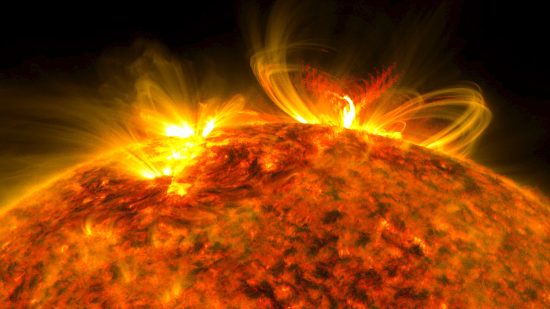
Apr 3, 2019
According to a recent press release, the electromagnetic field of the Sun is ten times stronger than previously reported.
Researchers from Queen’s University Belfast, using the Swedish 1-meter Solar Telescope at Roque de los Muchachos Observatory in the Canary Islands, analyzed the magnetic field strength of a strong solar flare. Since the conditions were perfect for observations, they were able to establish a measurement that is far more accurate than anything previously available.
Speaking about the find, Dr. David Kuridze said:
“Everything that happens in the Sun’s outer atmosphere is dominated by the magnetic field, but we have very few measurements of its strength and spatial characteristics….”
Astrophysicists who study solar flares say they appear when “magnetic energy that has built up in the solar atmosphere” is suddenly released.
As the article from Queen’s University states, “successful measurement of the magnetic field has been hindered by the weakness of the signal from the Sun’s atmosphere that reaches Earth and caries information about the magnetic field, and limitations in the instrumentation available.”
According to a popular view of the Sun, its core pressure is supposed to be so high that it crushes hydrogen atoms together until they fuse into helium atoms, releasing energy of such magnitude that Earth, 148 million kilometers away, is bathed in life-giving radiation. The Sun’s core is thought to be more than 15 million Celsius, and greater than 340 billion times Earth’s atmospheric pressure.
Above the photosphere, the part of the Sun that is seen, the chromosphere extends for thousands of kilometers. Above that, the corona extends for millions of kilometers. One of the greatest mysteries about the Sun is why the photosphere averages 6000 Celsius, while the corona can be as much as two million Celsius! Why does the hottest region of the Sun begin at an altitude of 4000 kilometers, extend over a million kilometers from its surface, and show no sign of a significant temperature drop?
The electric model sees sunspots, solar flares, coronal heating, and all other solar activity as fluctuations in the amount of charge flowing into the Sun. That electric current arrives in the form of plasma filaments that are gigantic in scale. They are extremely diffuse, but are so large that they carry tremendous amounts of electricity. Those Birkeland current filaments supply more or less power to the electric circuit powering the Sun.
Star power comes from external electric currents flowing through vast circuits in space, so the radiation and “wind” from the Sun are due to plasma discharge phenomena of various types that vary in strength. It is those phenomena that make up the stellar corona, chromosphere and photosphere of our Sun, for instance. The Sun’s energy is focused from the outside and not radiated from the inside.
An electric discharge in plasma creates a tube-like magnetic sheath along its axis. If enough current flows through the circuit, the discharge will cause the sheath to glow, sometimes creating a number of other sheaths within it. The sheath is called a “double layer.”
Double layers form when electricity flows in plasma, causing positive charges to build up in one region of a plasma cloud and negative charges to build up nearby. A powerful electric field appears between the two regions, which accelerates charged particles. Sometimes, the stored electrical energy in a double layer is catastrophically discharged in a “Langmuir burst.” Those bursts are what conventional astrophysicists call “magnetic reconnection.”
Plasma physicist Hannes Alfvén wrote (page 9): “The most important criticism of the ‘merging’ mechanism of energy transfer is due to Heikkila (1973) who with increasing strength has demonstrated that it is wrong. In spite of all this, we have witnessed at the same time an enormously voluminous formalism building up based on this obviously erroneous concept. Indeed, we have been burdened with a gigantic pseudo-science which penetrates large parts of cosmic plasma physics…We may conclude that anyone who uses the merging concepts states by implication that no double layers exist.”
Stephen Smith












